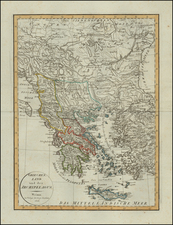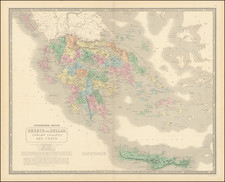Crete Iovis magni, medio jacet insula ponto, produced by Jan Jansson in Amsterdam around 1650, is an evocative engraved map of Crete, showcasing the combined efforts of renowned cartographers Ortelius and Jansson. Drawing from the original work of Ortelius, the map is adorned with a decorative cartouche, maritime vessels, and even a sea monster along its shores.
The map intriguingly highlights the island's mythological significance, suggesting the central placement of Jupiter within the island's geography, hearkening back to the tales of the deity's birth and upbringing. This intertwining of cartography and mythology is further emphasized by inscriptions, detailing names of locales, populations, rivers, mountains, lakes, temples, and islands.
The map's detail is further enriched by the listing of various place names, people, and natural features. While some of these names, like Adrafus and Athroua, are presented with relative certainty, others are labeled as being of uncertain position or origin, indicative of the challenges faced by cartographers of the era. This candid acknowledgment of the limits of knowledge underscores the evolving nature of geographical understanding in the 17th century.
https://www.alexandremaps.com/pages/books/M8308/jan-jansson-abraham-ortelius-janssonius/creta-iovis-magni-medio-iacet-insula-ponto
Jan Janssonius (also known as Johann or Jan Jansson or Janszoon) (1588-1664) was a renowned geographer and publisher of the seventeenth century, when the Dutch dominated map publishing in Europe. Born in Arnhem, Jan was first exposed to the trade via his father, who was also a bookseller and publisher. In 1612, Jan married the daughter of Jodocus Hondius, who was also a prominent mapmaker and seller. Jonssonius’ first maps date from 1616.
In the 1630s, Janssonius worked with his brother-in-law, Henricus Hondius. Their most successful venture was to reissue the Mercator-Hondius atlas. Jodocus Hondius had acquired the plates to the Mercator atlas, first published in 1595, and added 36 additional maps. After Hondius died in 1612, Henricus took over publication; Janssonius joined the venture in 1633. Eventually, the atlas was renamed the Atlas Novus and then the Atlas Major, by which time it had expanded to eleven volumes. Janssonius is also well known for his volume of English county maps, published in 1646.
Janssonius died in Amsterdam in 1664. His son-in-law, Johannes van Waesbergen, took over his business. Eventually, many of Janssonius’ plates were sold to Gerard Valck and Pieter Schenk, who added their names and continued to reissue the maps.










![A Mapp of The Estates of the Turkish Empire in Asia and Europe . . . 1669 [includes Cyprus]](https://storage.googleapis.com/raremaps/img/small/85533.jpg)


![Archipelagi Insularum Aliquot Descrip. [Crete, Metellino, Cerigo, Scarpanto, Nicsia, Santorini, Milo, Stalimene, Negroponte, Rodus and Scio]](https://storage.googleapis.com/raremaps/img/small/59922mp2.jpg)
![[ Greece, Bulgaria, Albania, Macedonia, Serbia & Turkey ] Tabula Europae IX](https://storage.googleapis.com/raremaps/img/small/74916.jpg)